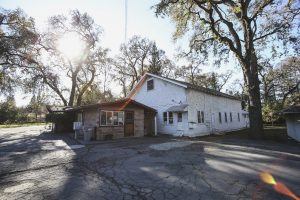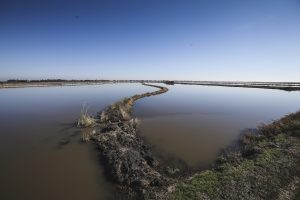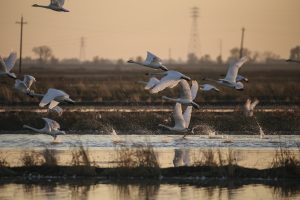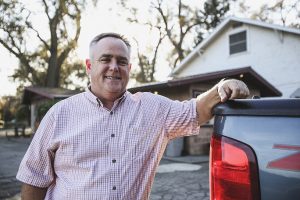 It is the dead of winter but the rice fields in the Sutter Basin are full of life. It’s the slowest time of year for most farmers; crops have been harvested and the spring planting season is months away. While most farmers patiently await the turn of season, fields southwest of Yuba City are busy producing a new type of food.
It is the dead of winter but the rice fields in the Sutter Basin are full of life. It’s the slowest time of year for most farmers; crops have been harvested and the spring planting season is months away. While most farmers patiently await the turn of season, fields southwest of Yuba City are busy producing a new type of food.
Roger Cornwell, the General Manager of the Basin Irrigation and Drainage Authority, knows there isn’t any money in growing tiny insects, but he’s banking on it leading to riches in another sense. The spineless orange bugs, known as cladocerans but also called a water flea, are no larger than a grain of rice, but they are the preferred meal of California’s Chinook salmon. Partnering with UC Davis, California Trout and State Water Contractors, Cornwell is hoping these tiny crustaceans thriving on his member’s rice fields can lead to a rebound of the salmon’s declining population numbers.
“There just aren’t enough of these insects in the Sacramento River to properly feed juvenile salmon,” said Cornwell. “The water is too cold and swift for the bugs to survive, leaving many malnourished salmon that are simply not strong enough to reach the Pacific Ocean.”
On rice fields however, these bugs reproduce with enthusiasm.

“When the fish are able to eat these insects found on the rice fields, the salmon grow three times the size of their counterparts which are forced to only eat what’s currently in the river,” said Cornwell. Now endearingly known as floodplain fatties, the increase in physical size is a positive indicator for survival; a promising development in the troubled history of this Northern California native species. Growing stronger, more agile and with the ability to prevail when food supplies are low, these floodplain fatties are seeing far improved odds at making it to the Pacific Ocean.
Since the fish can’t swim out onto rice fields, the partners have created a Blue Apron-style food delivery for the salmon.
“The process is fairly simple. We are borrowing the water from the river during the winter months, letting it sit out on the rice fields for a few weeks and then delivering the water back into the river recharged and full of bugs.”
The insects are able to reproduce at significant rates once sunlight breaks down the remaining rice straw, turning it into algae. The bugs feed off the algae and after a few weeks, the water is drained into the river for the young salmon. Then begins an epic chow down that would make Joey Chestnut look like an amateur.
We want to create an all-you-can-eat buffet for these salmon to help increase the number that will eventually return to spawn in the upper channels of the Sacramento River.”
 It is there in the upper channels where you will find another significant project his district is leading to help salmon. Located on the edge of Redding, Cornwell has partnered with scientists, Northern California Water Agency, National Marine Fisheries Service, Western Shasta Resource Conservation District and the US Bureau of Reclamation to provide very young salmon with shelter from larger prey.
It is there in the upper channels where you will find another significant project his district is leading to help salmon. Located on the edge of Redding, Cornwell has partnered with scientists, Northern California Water Agency, National Marine Fisheries Service, Western Shasta Resource Conservation District and the US Bureau of Reclamation to provide very young salmon with shelter from larger prey.
Using walnut trees bolted to granite boulders, the “rockwad” structures serve as protection from the swift current and larger predators. The program is already showing great progress.
 “We believe we can play an important role in helping salmon in various times of their lifecycle. All it takes is collaboration instead of infighting, and it is through focused coalitions that we can truly make a difference.”
“We believe we can play an important role in helping salmon in various times of their lifecycle. All it takes is collaboration instead of infighting, and it is through focused coalitions that we can truly make a difference.”
For Cornwell, the efforts won’t stop with these projects. As he sees it, the Sacramento Valley is just getting started.
So next time you see a flooded rice field in the middle of January, it may just be a farmer in the middle of his bug- growing season.
Listen to the podcast below.





Wonderful. I hope it is successful.